5 Tools for Creating Simple, Attractive Invoices
Key Takeaways
- Nutcache, Freshbooks, Zoho, Blinksale, and PayPal are all effective tools for creating simple, attractive invoices. Each has its own unique features and pricing, catering to different business needs.
- Nutcache is a free tool that offers invoicing, time management, and tax management tools. However, it does not allow for currency changes while making invoices.
- Freshbooks offers a free 30-day trial and paid accounts from $19.95/month. It provides live chat support, the ability to send invoices through snail mail, and a ‘Customer Coach’ for personalized assistance.
- Zoho offers a variety of services including an invoicing app. It has a free plan and paid plans from $15/month. It allows for currency changes, adding discounts, shipping charges, and late fees, and provides a customizable invoice template.
- Blinksale provides a minimalist experience with a 15-day trial and a single paid plan worth $15/month. It offers less complexity with fewer features but allows for currency changes and the addition of sales tax, freight charges, and late fees.
- PayPal, known for receiving payments, also allows for invoice creation. It offers customization options including adding discounts for individual items, changing the currency, and adding a custom value to the total figure.
When you start out as a freelancer — designer or developer — often it’s a part-time thing. Maybe you’re studying. Perhaps you’re ‘moonlighting’ outside your normal gig.
Your focus is going to be to present great work in the most professional manner possible.
Ideally, once your business grows big enough, you’ll hire a finance professional to do your invoicing. Till then, you need to depend on tools that help you look as professional as your longer-established and perhaps bigger competitors.
Happily, we live at a time where there are lots of high quality, cost-effective options to help you.
Recently Jacco covered fully-integrated accounting, finance and time-tracking solutions.
In this article, we just want to focus one very critical part of that process — the piece of paper that gets you paid. The following are all tools that can help you generate simple but attractive invoices.
Let’s get started.
Nutcache
Nutcache is a free online tool for invoicing and time management. It has the tools that are needed by freelancers or other small businesses to manage their finances.
Happily, Nutcache is a free tool and promises to always remain free. It’s used and recommended by SitePoint’s Design and UX editor Alex Walker.
On registering and logging you, the dashboard looks intuitive with useful links on the top. You are provided with quick links to get started in case you are overwhelmed with the options.
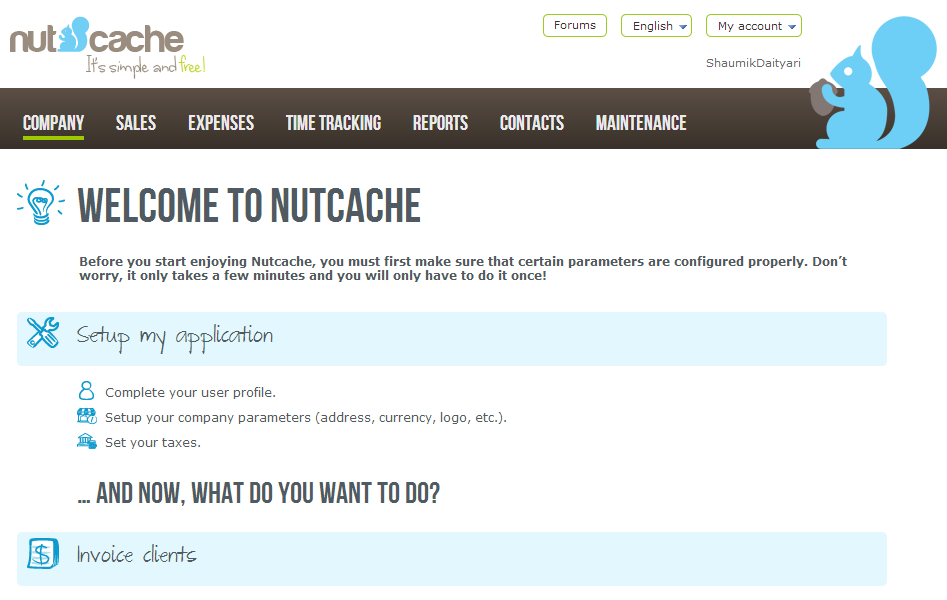
Let’s go straight to the invoicing tool by opting to create our first invoice.
Nutcache maintains clients, services and products- all of which are linked back to your invoice. You can add a client while creating your invoice.
Add the details of your invoice, the products and services offered and your invoice is ready. You can either export the invoice in a variety of formats (pdf, csv, xls, doc, ppt) or optionally send a mail to your client with the invoice. You can add a logo to your invoice by attaching one in the profile of your company.
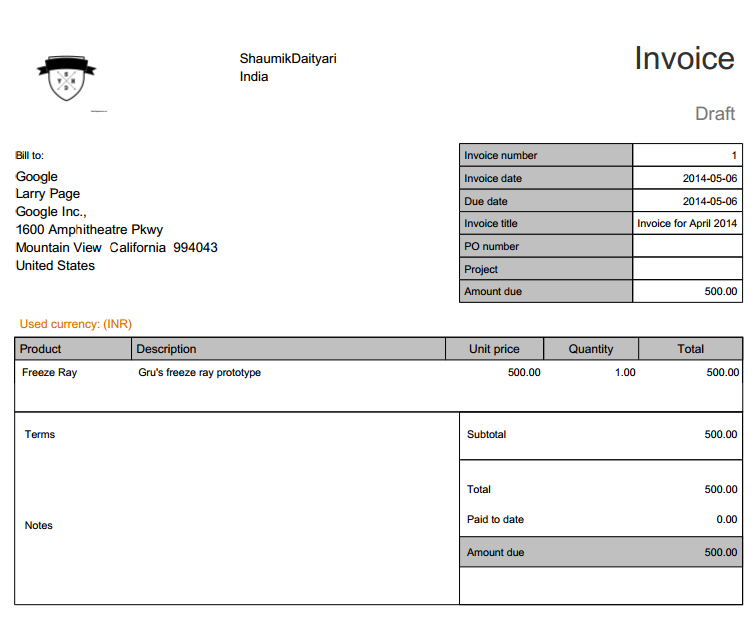
One issue with Nutcache is that you can not change the currency while making your invoice.
Yet, there are many other features that Nutcache provides that could be useful to a freelancer. You can add a payment gateway using PayPal, 2CheckOut or Authorize.Net to receive payments directly through the portal. Besides that, you are provided with time management tools not just for yourself, but for logging your employees as well.
Nutcache comes with tax management tools as well, which can be linked to the invoices being created. If you are a first time user, the variety of options can confuse you, but the quick links provided in your dashboard would surely help.
Freshbooks
Freshbooks is another online invoicing and accounting tool to manage your finances. It has a free 30 day trial, after which paid accounts start at $19.95 per month with a basic free plan.
Impressively, if you are stuck at something, chat box opens up in the right bottom corner enabling you to start a live chat. Freshbooks also lets you set a sub-domain to access your account.
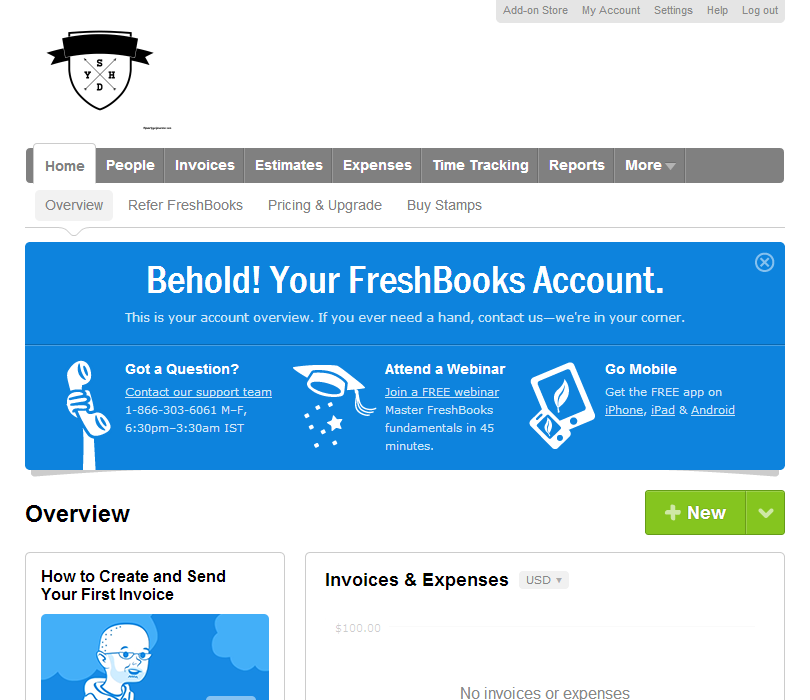
The process is quite similar to that of Nutcache, wherein you can add a client, a product or a service, add your invoice details and the invoice is ready!
It’s pretty simple to add your company logo and colors through your account settings. Freshbooks also enables you to send the invoice through snail mail to your client – which is a nice touch for ‘old-school’ clients.
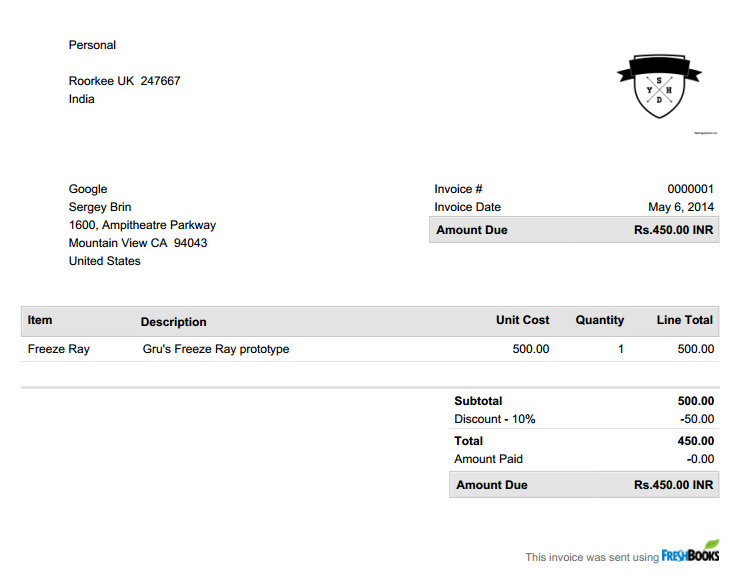
On the negative side, Freshbooks doesn’t allow you to change the currency while creating the invoice.
It provides an additional feature of adding a discount, though. You can customize your invoice template and title through the account settings. The free account provides two templates- classic and clean. The only difference is that the tables of the classic templates have borders. By default, the clean template is active (as seen in the screenshot).
Freshbooks also gives you some time management tools, add employees, integrate with payment gateways and generate reports. The facilities provided by Freshbooks are similar to that of Nutcache and I would suggest you enjoy the free services.
Lastly, Freshbooks personalizes the experience by assigning you a ‘Customer Coach’, who you could contact if you have any issues. You could arrange a time to talk to your coach or attend their regular webinars.
Zoho
Zoho provides a lot of services including an online office suite and business email, but prospering in the background is the Zoho invoicing app. The paid plans start from $15 per month, but it has a forever free plan as well.

Zoho has a very clean and organized dashboard with the standard features that are provided by other invoicing tools. You can create an invoice by providing the basic details of the client, product or service. You can attach your company logo in the organization profile.
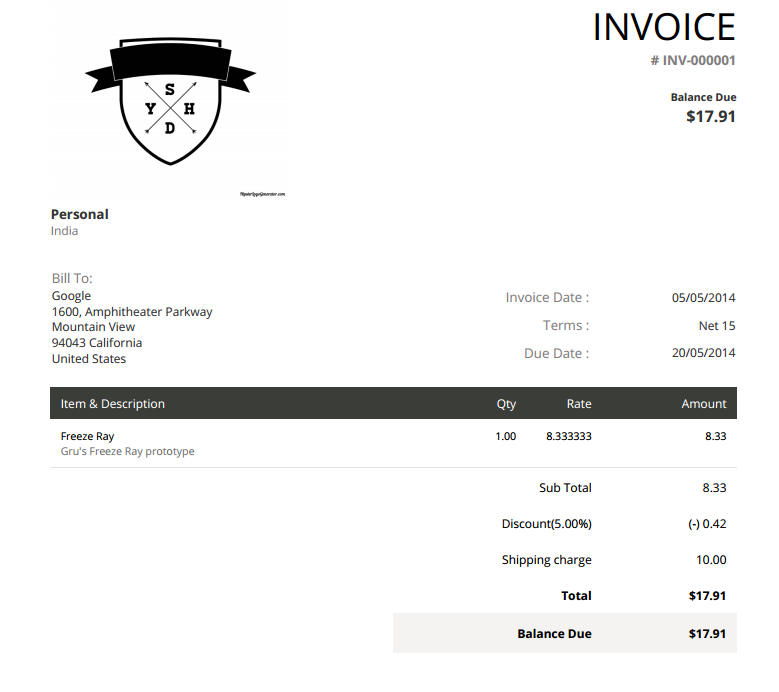
It is interesting to see that Zoho provides certain useful features while creating an invoice. You can add a discount, a shipping charge and a late fee. You can change the currency or the invoice, or provide it in a foreign currency with a specified exchange rate. You can also configure a payment gateway to accept payments through Zoho. You can send your invoice through snail mail too, but you need to buy credits to do so.
You have an option to change the template of your invoice by visiting the templates section under account settings. You can select a base template and customize it fully- right from the fields to display to the colors of the text and background for each field.
Zoho lets you keep track of your time with a time management tool, maintain expenses and estimates and generate detailed reports. Zoho tops it off with a flat UI design to make the overall experience very smooth. I may be biased because I use the same tool, but I feel Zoho does a great job of clubbing the features, yet keeping the options minimal.
For the impatient, Zoho provides an invoice generator, which lets you create invoices instantly and export them. You do not need to register or login, just visit the link, add the basic details and you are good to go!
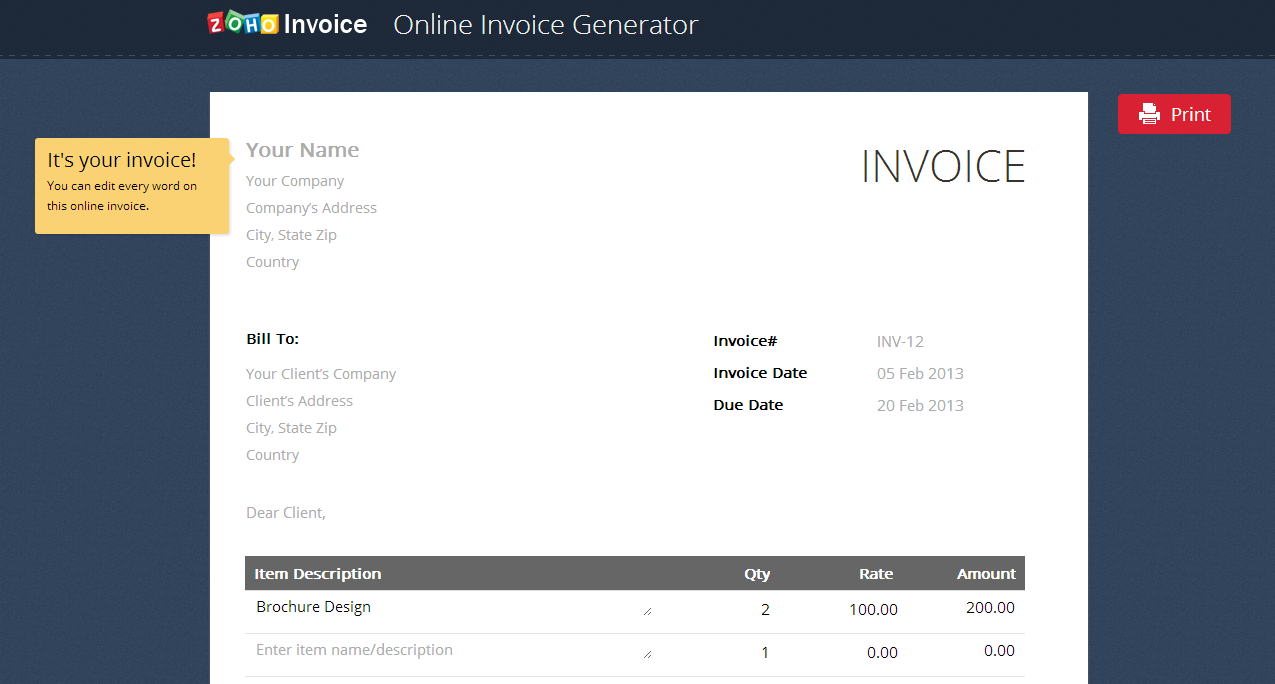
Blinksale
Blinksale is yet another online accounting and invoicing tool. It has a 15 day trial and a single paid plan worth $15 per month. It provides you a sub-domain, like Freshbooks. Blinksale has a less number of features, but it also offers less complexity.
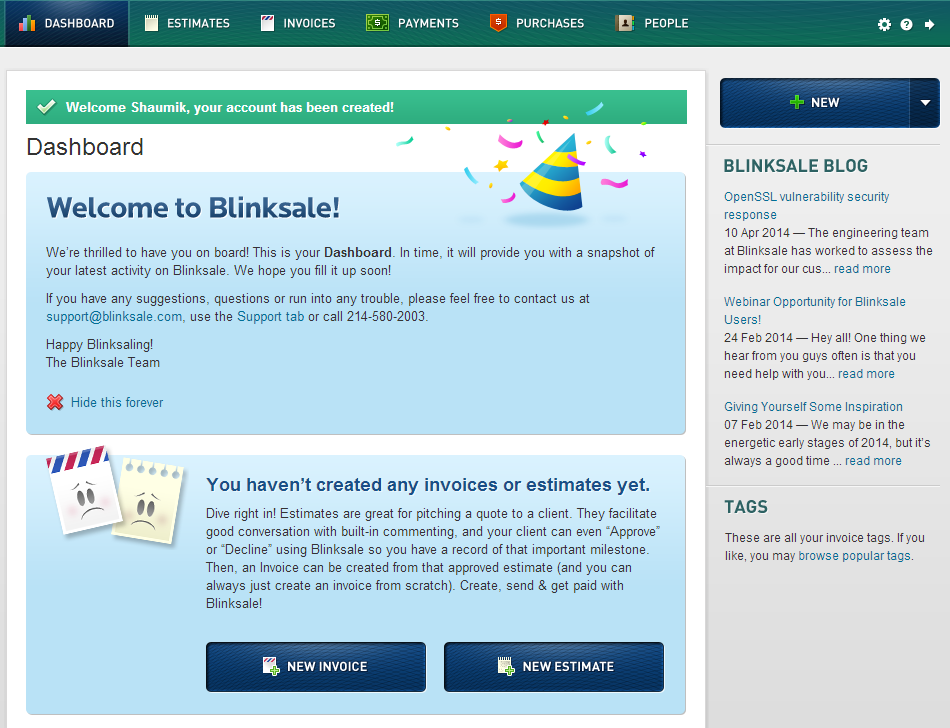
The invoice creating tool is basic in nature, allowing you to add a client and products or services. You can set the currency, add sales tax, freight charges and late fees if required. You can attach the company logo under your account settings.
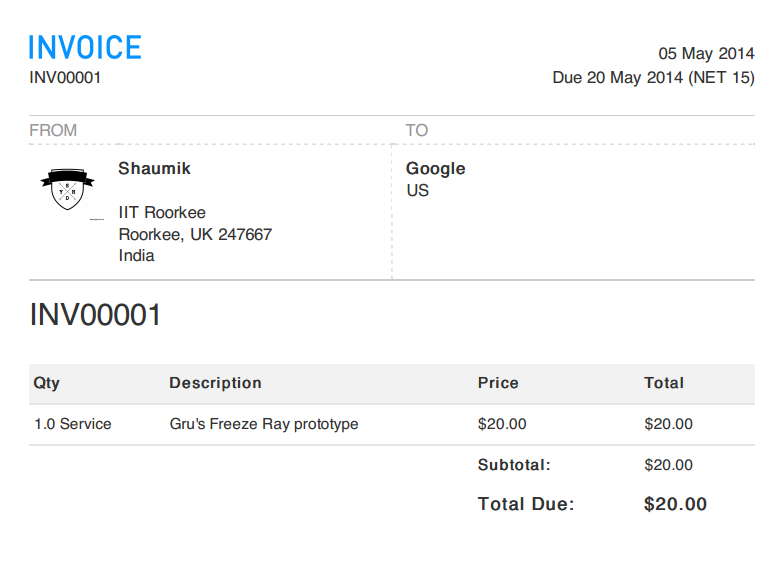
Blinksale does provide you with a choice of templates under account settings. If you do not like any of the provided templates, you can create a template using custom CSS by referring to their reference markup and standard CSS file.
Blinksale doesn’t provide any time management tool and there are no projects that can be associated with any of your invoices. However, this adds simplicity to the tool, which may affect the choice of certain people.
Overall, Blinksale gives a good minimalist experience.
PayPal
Although PayPal is generally used as a service to receive payments, many may not know that it provides you the ability to create invoices too!
You can create an invoice in PayPal by visiting the ‘Request a payment’ section in your profile, after logging in.
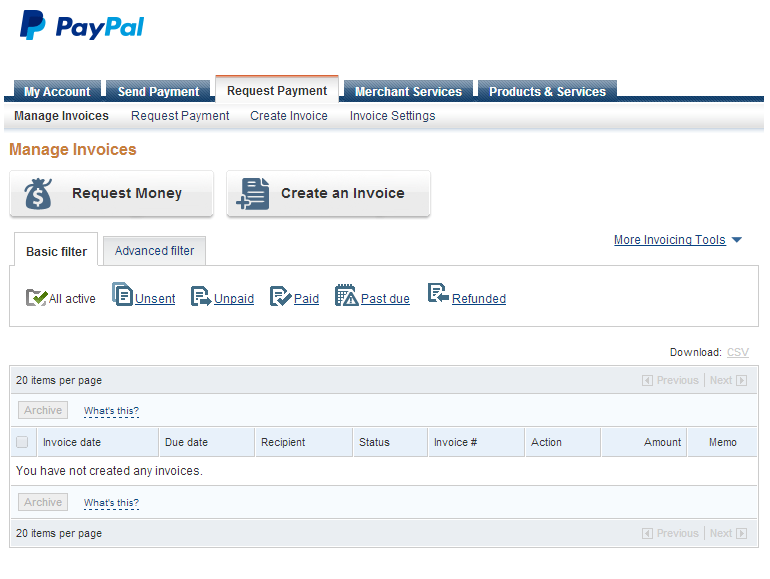
Add the basic details, attach your logo and list the services. You can add a discount, postage charges and taxes to your invoice. You may directly send the invoice through email to the client, or get a print out of the same.
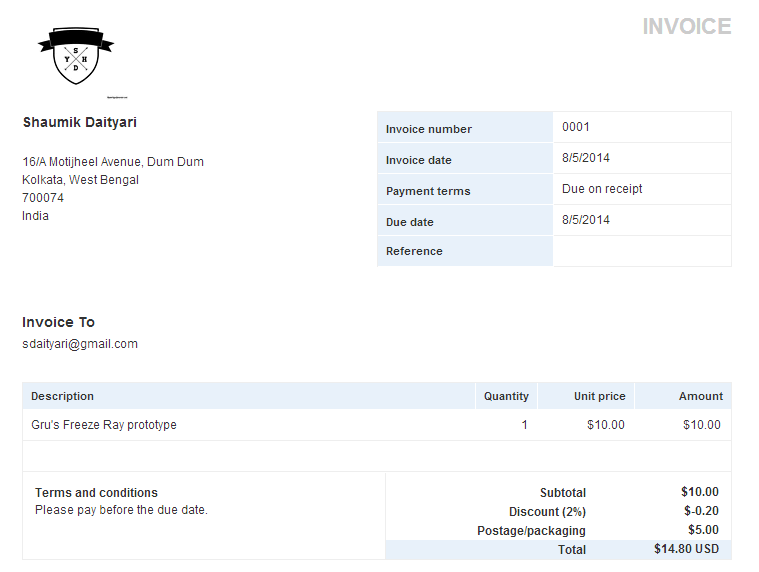
The invoicing tool allows you to further customize your invoice by creating templates. Some of the customizable options include adding discounts for individual items, changing the currency and adding a custom value to the total figure. The final look of the invoice remains similar to the default template though.
Conclusion
All the invoicing tools covered in this post let you create invoices — some with basic features, others with more full-featured offerings. All also have mobile apps for managing your finances.
In the end, it comes down to your requirements. Do you want a simple, low-learning-curve tool that just gives you fast invoices today? Or would you prefer system with the scope to grow with your business — even if you aren’t using all its functionality?
Do you want a free tool, or are you ready to pay monthly?
The choice is yours.
Frequently Asked Questions (FAQs) about Creating Invoices
What is the importance of creating a professional invoice?
A professional invoice is crucial for every business as it serves as a legal document that details the transaction between the seller and the buyer. It includes information such as the products or services provided, their costs, and the total amount due. A well-structured invoice not only helps in maintaining accurate financial records but also enhances the professional image of the business. It aids in tracking payments, predicting future revenues, and can be used as evidence in case of any legal disputes.
How can I create an invoice that is legally compliant?
To create a legally compliant invoice, it must include certain essential elements. These include the name and address of your business, the name and address of the customer, a unique invoice number, the date of the invoice, a description of the goods or services provided, the amount charged, and any applicable taxes. It’s also advisable to include payment terms and conditions to avoid any confusion or disputes.
What are the different types of invoices?
There are several types of invoices, each serving a specific purpose. Some common types include standard invoices, which detail what the client owes for a particular service or product; proforma invoices, which are used as a preliminary bill at the onset of a transaction; recurring invoices, which are used for ongoing services over a certain period; and credit invoices, which indicate a credit that the client has against certain goods or services.
How can I make my invoices look more professional?
To make your invoices look more professional, consider using a high-quality invoice generator or software. These tools often come with customizable templates that allow you to add your company logo, details, and terms of payment. Ensure that the layout is clean and organized, and the information is accurate and clear. Also, always double-check for any spelling or grammatical errors before sending out the invoice.
What is an invoice profile and how is it used?
An invoice profile is a predefined set of rules that determine how an invoice will be processed. It includes information such as the invoice format, the method of delivery, and the payment terms. Invoice profiles help streamline the invoicing process, ensuring consistency and accuracy in billing.
How can I manage unpaid invoices?
Managing unpaid invoices can be a challenge for many businesses. One effective way is to implement a systematic follow-up process. This could involve sending a reminder email or making a phone call a few days before the payment is due, and escalating the communication if the payment becomes overdue. It’s also important to maintain a professional tone throughout the process.
What is the difference between an invoice and a receipt?
While both invoices and receipts are related to business transactions, they serve different purposes. An invoice is a request for payment issued by the seller to the buyer, detailing the goods or services provided and the amount due. On the other hand, a receipt is a document acknowledging that a payment has been received.
How can I automate the invoicing process?
Automating the invoicing process can save time and reduce errors. This can be achieved by using invoicing software or tools that allow you to create, send, and track invoices with ease. Some software even offers features like recurring billing, automatic reminders, and integration with other business tools.
What should I do if a client disputes an invoice?
If a client disputes an invoice, it’s important to handle the situation professionally. Review the invoice in question and compare it with the agreed terms and conditions. If the dispute is due to a misunderstanding, clarify the details with the client. If an error has been made, correct it promptly and issue a new invoice.
Can I create invoices without using software?
Yes, it’s possible to create invoices without using software. You can use a simple spreadsheet or word processing program to create a basic invoice. However, using invoicing software or tools can make the process more efficient and professional, and can also help with tracking and managing your invoices.
Shaumik is a data analyst by day, and a comic book enthusiast by night (or maybe, he's Batman?) Shaumik has been writing tutorials and creating screencasts for over five years. When not working, he's busy automating mundane daily tasks through meticulously written scripts!
Published in
·Business·Entrepreneur·Entrepreneurship·Entrepreneurship·Freelancing·Management·Marketing·Revenue·August 7, 2015

